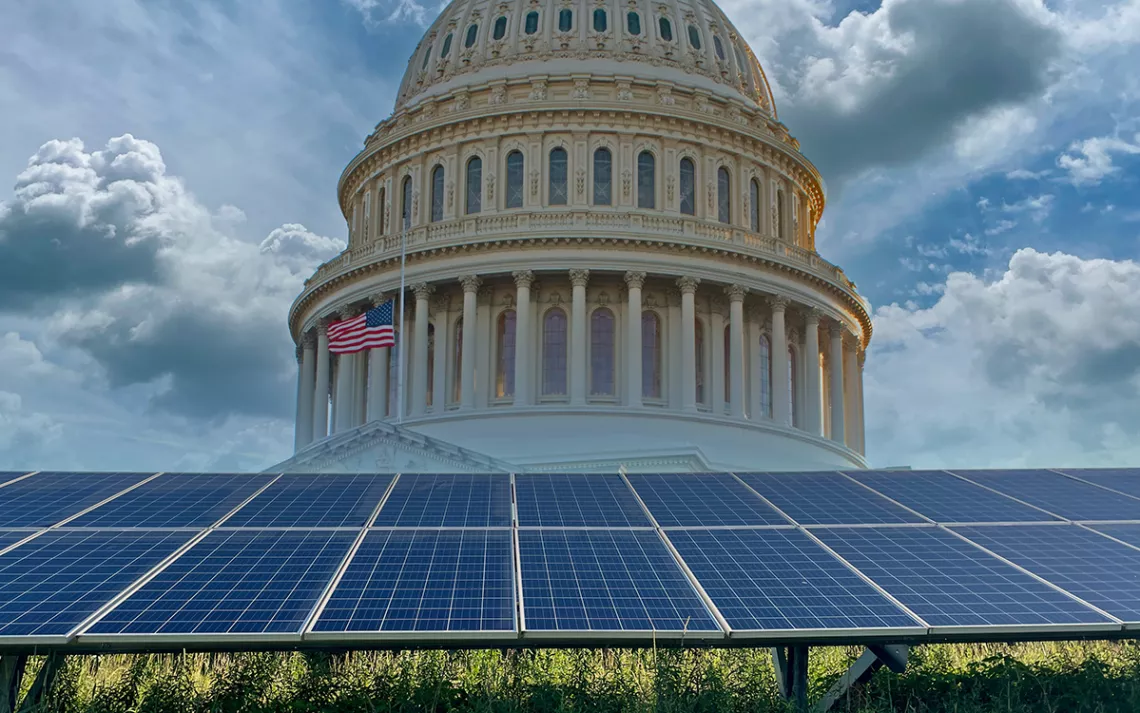Happy Birthday, Inflation Reduction Act
The landmark climate legislation is a marathon, not a sprint, but it’s already accomplishing its goal

One year ago today, President Biden and the then-Democratic-controlled Congress made history when they enacted the Inflation Reduction Act, the most ambitious climate change legislation in US history. On the law’s first anniversary, it seems only natural to take stock and see whether things are going according to plan.
But it turns out that judging the Inflation Reduction Act after one year is a bit like predicting the winner of a marathon based on who’s ahead after the first mile. That’s because, just like a 26-mile foot race, the IRA is a mammoth undertaking.
Over the course of a decade, new spending and tax incentives estimated at half a trillion dollars will go toward reducing carbon emissions. This is by design. The long-haul nature of the IRA is key to its potential for success, says Lori Bird, director of the US Energy Program at the World Resources Institute. “The fact that the incentives will be available for a 10-year period is a game changer for the clean energy industry,” she told Sierra.
That’s because investors need assurances of predictability before ponying up the billions needed to construct the giant manufacturing plants capable of turning out enough wind turbines, batteries, solar panels, and a thousand other components necessary for the United States to transition to a zero-carbon economy. Judging the success of the IRA after just one year is even more complicated, Bird said, because government agencies have spent much of the past 12 months writing and rolling out guidelines for how state and city governments and business can qualify for a share of the federal monies.
Despite the complexity and scope, Bird and other experts are bullish on the IRA, the largest federal investment in climate action in the United States to date. “In fact, we’re already seeing its impact all across the country,” Bird said.
She pointed to a recent study by the American Clean Power Association that reported 83 new utility-scale clean energy manufacturing facilities that have been announced since the Inflation Reduction Act became law. According to the trade association, these represent $270 billion in investment commitments, while creating 30,000 new jobs in 28 states. That’s more money dedicated to clean power than has been invested in the previous eight years.
Maren Mahoney directs Arizona’s Office of Resiliency, which was created, in part, to apply for the state incentives made possible by the Inflation Reduction Act and the Infrastructure Investment and Jobs Act of 2022. So far, Mahoney said, Arizona has secured over $1 billion for clean energy development, creating 12,000 jobs. She believes the state ranks number one in creating those new jobs in communities of color, especially among the state’s large Latino population. “There’s so much we need to get done,” she said, “but there’s now so much opportunity as well.”
Although the Inflation Reduction Act didn’t garner a single Republican vote in either the US House or Senate, the new clean energy infrastructure is being built in both red and blue states. While that may sound unfair to the Democrats who passed the bill, it’s good news for the long-term prospects of a zero-carbon economy, according to Jackson Ewing, director of energy and climate policy at the Nicholas Institute of Energy, Environment and Sustainability at Duke University. “We’re seeing amplification of clean energy business opportunities created by the IRA all across the country, regardless of politics,” Ewing said.
No state wants to miss out on the enormous subsidies and benefits of the law. Once established, giant clean energy manufacturing hubs become all about good jobs and tax revenues, insulating them from political battles over climate change. Even politicians who claim not to accept the science of global warming are more than happy to take credit when a new clean energy facility opens in their district.
No matter how much money is invested or how many jobs are created, the impressive figures are meaningless if they exist on a planet made uninhabitable by a changed climate. Ultimately, the only numbers that matter are how much carbon emissions are cut and how quickly we do it. One of the most widely accepted estimates of those numbers are found in a report published annually by the independent research firm the Rhodium Group.
According to its most recent report, by 2030 the Inflation Reduction Act will reduce US emissions by 29 to 42 percent below 2005 levels. That’s a historic cut. But it’s not enough to meet the US commitments made in the Paris Agreement to reduce carbon emissions by 50 to 52 percent by 2030. Given the decade-long nature of the Inflation Reduction Act, the picture for 2035 looks better, with an estimated 32 to 51 percent reduction.
Ben King, the lead author of the Rhodium study, is convinced that the IRA is “a turning point” in the fight against climate change. To fully decarbonize by 2050, King said, “the IRA is a necessary condition. But it’s not sufficient by itself.”
That’s because it was never meant to be a panacea.
“A sustained stream of federal and state actions is the only way to close the US emissions gap,” King and his coauthors wrote.
The role of states is critically important, King said, pointing to state actions already underway. California is the nation’s most populous state and the fifth-largest economy in the world. It also has a long record of being a trend-setter for environmental policies. Last year, the state set a 2035 deadline for ending the sale of new vehicles powered by internal combustion engines. In the first quarter of 2023, one in every four new vehicles sold in that state were zero-emission—a nearly 40 percent increase over 2022 sales. That’s a crucial part of the decarbonization process because since 2017, transportation has been the number one source of US carbon pollution surpassing electrical generation.
“Most of us don’t live in California, however,” King pointed out, “so we need to keep pushing in that direction in other states.” That’s already begun, with six other states—Maryland, Massachusetts, New Jersey, New York, Oregon, Washington—now following California’s lead in phasing out gas-powered vehicles.
The Inflation Reduction Act contains tax deductions for consumers who buy zero-emission vehicles, as well as for battery manufacturers, both of which should speed up the decarbonization of transportation by helping to solve what’s known as the “stock turnover” problem. “The average age of a car on the road right now is 12 or 13 years,” King explained. “It’ll take awhile to replace them all with zero-emission vehicles, so the benefits of the phase-out will take some time.”
Time is not on our side, however. At current emission levels, we’re likely to pass the critical warming threshold of 2.7°F (1.5°C) above the preindustrial average temperature in less than a decade. A slew of climate catastrophes are likely to occur if that happens. A mere sample of life at that temperature occurred in July, when, for the first time, Earth’s average temperature for the month reached that 2.7° level. It was the hottest July on record, and the results were devastating: massive die-offs on coral reefs, flooding, extreme heat records shattered from California to Florida, and now, cataclysmic wildfires that are still smoldering on the drought-stricken Hawaiian island of Maui. Last week’s fire was the deadliest in the US in over a century.
One time-sensitive component is reducing greenhouse gas emissions from the United States’ second-largest source of carbon pollution: electrical power plants. Utilities will need to build wind- and solar-powered plants to meet regulations proposed by the Environmental Protection Agency in May. According to the Rhodium Group’s projections, the United States needs to add 32 to 92 gigawatts of electricity from wind and solar each year until 2035 to meet the country’s climate goals. That’s a daunting task given that the low-end figure of 32GW is roughly equal to our best year on record—and 92GW is triple that.
But there’s reason for hope, said Michael Gerrard, director of the Sabin Center for Climate Change Law at Columbia Law School. “We've seen a huge increase in offshore wind from what was basically a standing start,” he said, pointing to 25GW of offshore wind projects in various stages of construction on the East Coast, more starting on the West Coast, and an announced lease sale later this month for offshore wind projects in the Gulf of Mexico.
The success of those projects depends on building thousands of miles of new or upgraded transmission lines. To accomplish that build-out, we’ll have to speed up the permitting process that can slow construction to a crawl, experts say. “Local and environmental opposition sometimes get in the way of permitting,” Gerrard said. But he sees progress on that front too. In 2019, the Audubon Society warned that two-thirds of bird species in North America could go extinct if climate change isn’t brought under control. In a new report issued by the group this month, Audubon spoke a hard truth to its members: While new transmission lines will pose hazards to birds, the threat from unmitigated climate change is far greater. Instead of blocking new transmission lines, the organization wrote, Audubon was uniquely qualified to ensure that the needed infrastructure was built out “in a way that maximizes clean energy development while minimizing negative impacts on birds, wildlife, and people.”
Gerrard also sees progress on another permitting front. “Many local governments had adopted laws that inhibit renewables,” he said. New research by the Sabin Center found that 12 states have passed laws that preempt those local bans.
Will it be enough?
All the experts interviewed agreed that the Inflation Reduction Act alone won’t head off the worst effects of climate change. “The IRA isn’t sufficient to get all of the carbon reduction that we need,” Bird concluded, “but it’s an excellent step in the right direction.”
King from the Rhodium Group sees the IRA as both an invaluable initiative and a call to collective action. “I hope people come away from this feeling a glimmer of hope,” he said, “and ready to fight for as aggressive an amount of decarbonization as possible.”
To Ewing, the Inflation Reduction Act makes the US position analogous to that of “a top-tier athlete coming off an injury.” As the world’s largest economy, our potential to fight climate change is enormous. So far, the United States has failed to live up to that potential. “The IRA is a more ambitious approach to our national energy transition than anything that’s preceded it in the modern era,” he said. “In that sense, we are now in the game in a new way.”
 The Magazine of The Sierra Club
The Magazine of The Sierra Club



